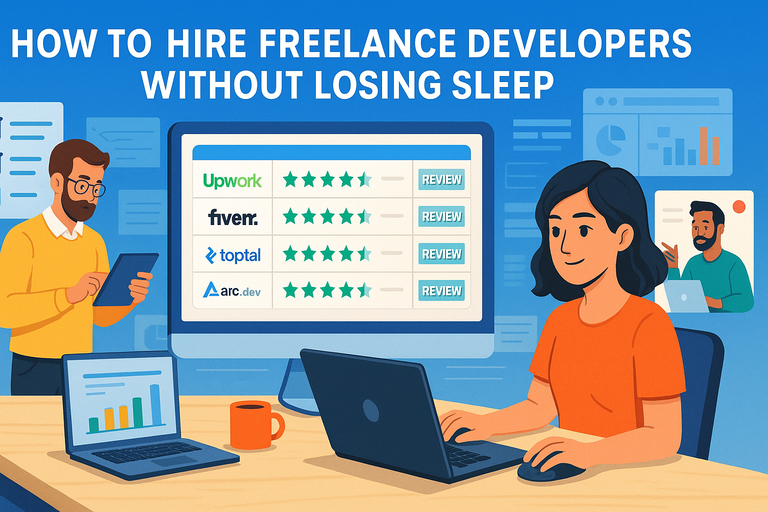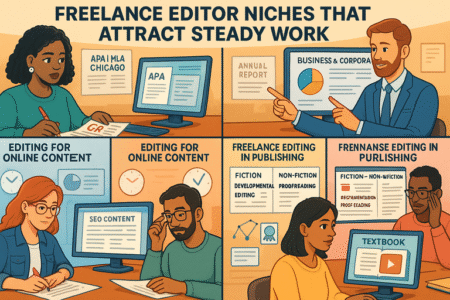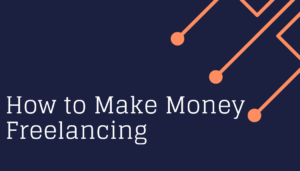Table of Contents
When you try to hire freelance developers, it can feel like gambling with your time, money, and peace of mind. What if the person you bring on disappears halfway through the project?
Or worse, delivers sloppy work you can’t use? The good news is, there are proven ways to find reliable talent without tossing and turning at night.
So how do you separate trustworthy freelancers from risky ones? That’s exactly what this guide will unpack.
Define Clear Project Requirements Before Hiring
Before you even start scrolling through profiles to hire freelance developers, you need to know exactly what you’re asking for. A vague job description is the fastest route to disappointment.
The clearer your project requirements, the more likely you’ll attract the right talent and avoid costly missteps.
Break Down Your Project Into Specific Deliverables
Think of your project as a recipe. If you only say, “I want a cake,” you could end up with anything from a dry pound cake to a five-layer chocolate mousse. Instead, list the ingredients and steps.
For example:
- Homepage design with responsive mobile view
- Login system with Google and Facebook integrations
- Payment gateway setup with Stripe
The more detailed you are, the easier it is for a developer to give you an accurate proposal. I recommend writing deliverables in bullet-point format so nothing gets lost. It also sets a baseline to measure progress later.
Set Realistic Timelines That Freelancers Can Commit To
Every developer has a different pace. If you’re expecting a full web app in a week, you’re setting yourself up for delays and stress. Break projects into smaller milestones.
For instance:
- Week 1: UI/UX mockups delivered
- Week 2: Backend setup completed
- Week 3: Beta version deployed
This not only keeps things manageable for the freelancer but also gives you checkpoints to catch issues early instead of three months in.
Create a Budget Range That Matches Skill and Quality
This part is tricky because it’s easy to underestimate costs. Cheap doesn’t always mean bad, but you’ll often get what you pay for. Instead of setting a fixed number, create a range.
For example: “$1,500–$2,500 depending on experience and delivery speed.” This allows room to attract both mid-level and advanced developers. I’ve found that being upfront about budget saves endless back-and-forth later.
Use Documentation to Avoid Misunderstandings
The biggest source of conflict? Miscommunication. I suggest creating a simple Google Doc or Notion page that outlines:
- Deliverables
- Timelines
- Payment schedule
- Tools required
If you want to go further, you can add screenshots, wireframes, or even flowcharts. When expectations are written down, there’s little room for “I thought you meant this.” Documentation turns abstract ideas into concrete commitments.
Choose the Right Platform to Hire Freelance Developers
Once your project requirements are nailed down, the next step is finding the right hunting ground. Not every platform is equal.
Some are crowded marketplaces where you’ll sift through hundreds of proposals, while others pre-vet developers to save you time.
Compare General Platforms Like Upwork and Fiverr
General marketplaces are great if you want variety. Upwork, for example, lets you post a job and receive dozens of applications within hours. Fiverr works differently — you browse through pre-packaged services, almost like an online store.
- Upwork is better for long-term, complex projects where you need custom proposals.
- Fiverr is handy for smaller, clearly defined tasks, like “Fix my WordPress bug.”
I’d advise using these platforms if you want a wide talent pool and flexibility in pricing.
Explore Tech-Specific Marketplaces Such as Toptal or Arc.dev
If you want highly vetted talent, marketplaces like Toptal or Arc.dev are worth exploring.
Toptal claims to accept only the top 3% of applicants, which means you’ll get seasoned developers who can often hit the ground running.
Arc.dev focuses specifically on developers, offering both freelancers and remote employees. These platforms tend to be pricier, but they save you time in vetting.
Consider Niche Communities Like GitHub or Stack Overflow
Sometimes the best developers don’t even advertise on freelance platforms.
GitHub is where developers showcase their projects — if you see someone building exactly what you need, you can reach out directly.
Stack Overflow, on the other hand, has job boards where experienced developers often look for side projects. While this takes more legwork, you may find hidden gems that aren’t competing in crowded marketplaces.
Evaluate Local Versus Global Freelance Hiring Platforms
Hiring globally gives you access to diverse talent and often lower costs, but time zones can be a hurdle. If daily communication is key, a local platform might make more sense.
For example, hiring through platforms that focus on your region means easier collaboration in real time. On the flip side, global hiring means you’re not limited by geography — you can find a React developer in Eastern Europe or a Python expert in India.
Vet Freelance Developers With a Proven Process
Hiring the right freelancer isn’t luck — it’s process. If you want to hire freelance developers without losing sleep, you need a system that filters out the noise and helps you spot real talent before you hand over your project.
Review Portfolios for Relevant Technical Experience
A portfolio is like a developer’s highlight reel. But don’t just skim flashy screenshots. Look for work that matches what you need.
For example, if you’re building an e-commerce store, a portfolio full of SaaS dashboards isn’t necessarily relevant.
What I suggest is this:
- Check if their projects use the same tech stack as yours (React, Node.js, WordPress, etc.).
- Look for live links, not just mockups. Real, working products tell you more than polished images.
- Ask them to walk you through one project: “What was your role? What problem were you solving? What challenges came up?”
This gives you insight into how they think, not just what they built.
Check Ratings, Reviews, and Client Feedback
Reviews can reveal a lot about consistency and professionalism. I don’t just look at five-star ratings — I pay closer attention to the middle-ground reviews. Those usually highlight strengths and weaknesses honestly.
A quick hack: scan for repeated words in reviews. If three different clients mention “great communication” or “always on time,” that’s a reliable signal.
On the flip side, if multiple clients mention missed deadlines, that’s a red flag you can’t ignore.
Test Communication Skills Through Early Conversations
I can’t stress this enough: good communication is just as important as good code. Schedule a short call or chat before committing. Notice if they:
- Ask clarifying questions
- Rephrase your requirements to confirm understanding
- Offer suggestions instead of just saying “yes” to everything
If you’re struggling to get clear answers at the start, it won’t magically improve once money is on the line.
Use Small Paid Test Projects to Measure Quality
This is my favorite safeguard. Instead of jumping into a $10,000 contract, start with a $200 test task.
For example: ask them to build one feature of your app or fix a tricky bug.
Why this works:
- You see their code quality in action
- You test how they handle deadlines
- You check how they communicate progress
I’d rather pay a little upfront to confirm someone’s skills than gamble the whole budget and hope it works out.
Focus on Skills That Go Beyond Code
Writing clean code is only part of the job. The best freelance developers bring more to the table: they solve problems, collaborate, and understand how their work connects to your business goals.
Look for Problem-Solving and Critical Thinking
A developer who just follows instructions is a short-term solution. A developer who spots problems before they become disasters? That’s gold. I suggest giving them a scenario during your vetting:
“Here’s a feature I want. What challenges do you think could come up?”
Their answer tells you how they approach problem-solving. If they anticipate issues like database scaling or security gaps, you know they’re thinking beyond just “make it work.”
Evaluate Collaboration and Teamwork Attitudes
Even if you’re hiring a single freelancer, collaboration matters. They may need to work with your designer, marketer, or in-house developer. Ask them how they usually share updates. Do they prefer Slack, Trello, or email?
Look for signs they value feedback instead of being defensive. A developer who can accept critique gracefully will save you countless headaches.
Check Adaptability to Tools and Workflows
Every team has its own setup. Maybe you use Jira, Notion, or Asana to track progress. A good freelancer doesn’t need months of onboarding — they adapt quickly.
In my experience, the best freelancers say things like: “I’ve used Trello before, but I can switch to Notion if that’s easier for your team.” Flexibility here makes collaboration smoother and avoids friction.
Ensure They Understand Business Goals, Not Just Code
This is where great freelancers stand out. If you say, “I need a checkout page,” the average developer will build one. But a great one will ask:
- “Do you need it optimized for one-click purchases?”
- “Do you want built-in analytics to track abandoned carts?”
They connect the technical work to the outcome you actually care about: conversions, retention, or user experience.
I always advise giving developers context about your business goals. If they lean in and start brainstorming, you’ve likely found a keeper.
Communicate Expectations Upfront and Clearly
Most hiring mistakes don’t come from bad code, they come from unclear expectations.
If you want to hire freelance developers without losing sleep, start with conversations that remove guesswork before the first line of code is even written.
Agree on Tools for Communication and Project Tracking
Don’t assume your freelancer will know your workflow. Pick the tools together and stick to them. For example:
- Use Slack or Microsoft Teams for quick daily updates.
- Track tasks in Trello, Asana, or Jira so progress is visible.
- Share files in Google Drive or Dropbox to avoid scattered documents.
I recommend setting this up right after you hire. For instance, “From the Trello dashboard, click ‘Create Board’ and name it after your project.”
Then invite the freelancer and assign the first tasks. This avoids confusion and keeps you both looking at the same source of truth.
Define Milestones and Payment Schedules in Advance
Breaking work into milestones protects both sides. It’s less risky for you and gives freelancers motivation to stay on track.
Example setup:
- Milestone 1: Design mockups delivered → 20% payment
- Milestone 2: Core features functional → 40% payment
- Milestone 3: Final product tested and delivered → 40% payment
I’ve found this setup creates mutual trust. You’re not paying for unfinished promises, and they’re not waiting months for compensation.
Set Availability and Response Time Expectations
Every freelancer has their own rhythm, and mismatched expectations can cause friction. If you expect a reply within an hour but they check messages once a day, frustration builds fast.
I suggest agreeing on specifics like:
- “I’ll need a reply within 24 hours on weekdays.”
- “Let’s schedule a 30-minute check-in twice a week.”
This way you know when you’ll hear from them, and they know when they’re expected to be available.
Clarify Ownership of Work and Intellectual Property
This one gets overlooked often. Make it explicit: once the work is paid for, you own it.
Whether it’s code, design, or content, ownership should transfer upon payment. If you don’t clarify this upfront, you risk disputes later.
A simple line in your agreement like, “All rights to the deliverables transfer to the client upon final payment,” saves you from potential headaches.
Protect Yourself With Solid Contracts and Agreements
Contracts may sound stiff and formal, but they’re your best safety net when hiring freelance developers. A well-written agreement protects both sides, so nobody feels cheated.
Use Written Contracts to Cover Scope and Deliverables
Think of your contract as the “project map.” It should spell out exactly what’s being built and what’s not.
Example:
- Included: Homepage, product pages, and shopping cart
- Not included: Ongoing SEO, server maintenance, or third-party costs
Having this in writing avoids scope creep, where freelancers get asked to do “just one more thing” for free — or where freelancers claim something was “extra” after the fact.
Include Confidentiality and Non-Disclosure Clauses
If your project involves sensitive information — like business plans, user data, or unique algorithms — include an NDA (non-disclosure agreement).
This legally binds the freelancer from sharing or reusing your ideas. Even a simple one-page NDA can give you peace of mind.
Define Payment Terms and Late Delivery Penalties
Clear payment terms avoid awkward conversations later.
For example:
- “Invoices are due within 7 days of delivery.”
- “If delivery is delayed by more than 7 days without approval, payment may be reduced by 10%.”
This sets a standard that both sides agree on, instead of vague “I’ll pay when I get around to it” arrangements.
Consider Escrow Services for Extra Security
Escrow adds another layer of protection. Platforms like Upwork automatically hold your payment until the freelancer delivers the milestone. This reassures freelancers they’ll get paid and reassures you that you won’t lose money on unfinished work.
If you’re hiring outside a platform, you can still use independent escrow services. I’ve done this a few times for bigger projects, and it made everyone more comfortable.
Manage Freelance Developers Like a Pro
Hiring the right freelancer is just the start. Managing them well is what turns good work into great results. Without structure, even talented developers can drift off track.
Use Project Management Tools for Transparency
I strongly advise setting up a shared project board. Tools like Trello, Jira, or Asana make progress visible at a glance.
For example, in Trello you can set up three columns:
- To Do
- In Progress
- Done
Drag-and-drop updates are simple, and you can attach files or comments right to each task. This keeps everything organized and avoids endless email chains.
Schedule Regular Check-Ins to Keep Progress Visible
A 15–30 minute weekly call can save you hours of confusion. Use this time to:
- Review what’s been completed
- Discuss any blockers or delays
- Adjust priorities for the coming week
I’ve noticed that without these check-ins, even small misunderstandings can snowball. Quick conversations keep everything aligned.
Balance Trust With Accountability in Oversight
Micromanaging kills motivation, but disappearing completely creates risk. The sweet spot is staying present without hovering. I recommend:
- Trusting them to execute tasks without constant interruption
- Reviewing deliverables at each milestone to confirm quality
- Using progress tracking tools to see updates without chasing them
This balance gives freelancers freedom to do their best work while still keeping you in control of outcomes.
Provide Constructive Feedback Instead of Micromanaging
When you spot issues, frame feedback as guidance, not criticism.
For example:
- Bad: “This isn’t what I asked for. Redo it.”
- Better: “I like the functionality, but could we adjust the layout so it’s more mobile-friendly?”
Freelancers respond far better to specific, actionable feedback than to vague complaints. Over time, you’ll build mutual trust that makes collaboration smoother.
Build Long-Term Relationships With Reliable Freelancers
When you finally find a great freelancer, don’t let that connection go cold. Long-term relationships save you the stress of repeating the whole hiring cycle every time a new project pops up.
Rehire Proven Developers for Future Projects
If a freelancer has delivered solid work, clear communication, and met deadlines, I recommend rehiring them. The onboarding process will be smoother the second time because they already know your workflow, tools, and preferences.
I’ve seen projects move 30–40% faster when working with someone who’s already familiar with my style.
Keep a simple “freelancer roster” in a spreadsheet or project management tool with names, skills, and past performance notes. That way, the next time you need a React developer or a WordPress specialist, you won’t be starting from scratch.
Offer Incentives for Consistency and Loyalty
Freelancers aren’t employees, but you can still reward loyalty. Small gestures go a long way:
- Offering a bonus for early delivery
- Referring them to other clients
- Guaranteeing recurring monthly work
In my experience, freelancers who feel valued are more likely to prioritize your projects over random one-off jobs.
Create a Feedback Loop to Improve Collaboration
Feedback shouldn’t only happen when something goes wrong. Share what’s working well, too.
For instance, say, “I loved how you gave me two options for that design — that was super helpful.” Positive reinforcement builds trust and motivates them to keep going the extra mile.
Set up a simple routine, like a monthly review call, where both sides can discuss improvements. This kind of feedback loop builds a healthier partnership.
Develop a Small Network of Trusted Freelancers
Don’t rely on just one person. Even the most reliable freelancer can get sick, booked up, or unavailable.
I suggest building a small, trusted circle of 2–3 developers with different specialties. This backup system ensures your projects don’t stall if one person can’t take on work.
Over time, this network becomes your “extended team” — people you trust, who understand your business, and who can jump in without a long onboarding.
Know Red Flags That Save You From Stress Later
The earlier you spot red flags, the less stress you’ll deal with down the line. Not every freelancer who looks good on paper is a safe bet.
Watch Out for Overpromising or Unrealistic Claims
If someone promises to build your full SaaS app in a week for $300, that’s not a deal — that’s a disaster waiting to happen.
I always say: If it sounds too good to be true, it probably is. Reliable developers give realistic timelines and explain why.
Be Careful With Poor Communication or Delayed Responses
If you’re waiting three days for a reply before the project even starts, imagine what it’ll be like during crunch time. Poor communication is usually the first sign of deeper issues.
Test this early: send a detailed question during the vetting stage. Notice how quickly and clearly they reply. If the response feels vague or takes too long, that’s a warning sign.
Avoid Developers Who Refuse Contracts or Milestones
Any freelancer who says, “We don’t need a contract” or pushes back against milestone-based payments should raise alarm bells.
Professionals value clarity — avoiding contracts usually means they want to leave things open-ended, which benefits them but not you.
Notice Patterns of Negative Reviews From Past Clients
One bad review might just be a mismatch. But repeated complaints about missed deadlines, poor quality, or disappearing mid-project? That’s a trend you can’t ignore.
I suggest creating a quick notes document during vetting: Jot down what you notice across reviews. Seeing issues written side by side makes patterns easier to spot.
Save Time and Stress With Hybrid Hiring Options
Sometimes the smartest move is blending freelance flexibility with more structured solutions. Hybrid options give you reliability without losing agility.
Consider Freelance Agencies for Pre-Vetted Talent
Agencies often have teams of developers with varied skills, so you don’t have to hire multiple freelancers individually.
You also get built-in project management support. While agencies cost more, they reduce the time you spend searching and vetting.
Use Managed Platforms That Handle Payments and Contracts
Platforms like Toptal and Arc.dev don’t just match you with freelancers — they also manage contracts, payments, and sometimes even progress tracking.
This removes much of the administrative overhead and gives you peace of mind.
For example, with managed platforms you often deposit funds upfront, and the platform releases payments only when milestones are met. It’s like built-in escrow protection.
Try Remote Staffing Services for Dedicated Developers
If your project requires long-term commitment, remote staffing services give you dedicated developers who work almost like employees.
You get stability without committing to full-time hiring. This is great for startups that need consistent coding power but can’t yet afford permanent staff.
Blend Freelance and In-House Teams for Complex Projects
For bigger projects, a hybrid model works wonders. Imagine having your core in-house team focus on strategy and sensitive tasks, while freelancers handle specialized or overflow work.
I’ve seen this setup cut project costs significantly while still maintaining quality. It also prevents burnout for your in-house team since freelancers pick up the extra weight when deadlines get tight.






